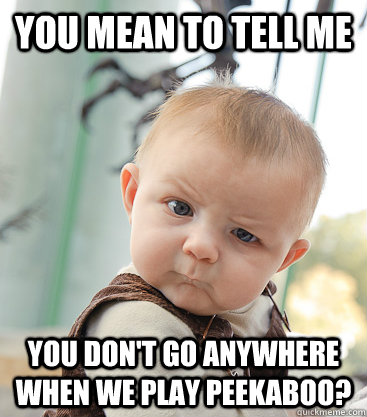In Merleau-Ponty’s “The Spatiality of One’s Own Body and Motility” he spends a great portion of his analysis of perception discussing what it means to be made up of a bodily schema, the physical connection to consciousness, and situating oneself within the “world.” One of the most compelling examples he uses throughout is the process of a fully functional human losing their ability to recognize this relational schema through illness or some other type of loss of perception. He indirectly likens this experience to a child’s inability to fully grasp knowledge. With the child in mind, I read this chapter instead from a developmental position. At what point does a child achieve the ability to perceive one’s self, one’s body and attain some kind of understanding of that position in the world?
Developmentally, I suppose the toddler starts to discover multiple uses for their hands as tools, to hold a sippy cup, to grasp cheerios, etc. These hands have a purpose and it is through the sensation the child perceives that they become aware and seek out more and more bodily sensations. The motility of the body is reinforced through the visual of all this happening in front of the child. It is further reinforced through audial encouragement. So, is it this process of experimentation that the child is able to “understand” the body and can then begin to place itself in the world. Is the child aware of what is happening on some type of experiential level? Is this the beginning of a “framework for a whole series of thoughts and experiences” (146)?
The development of bodily sensation and knowledge of a placement within one’s own space and time is evident in children when they play repetitive games. The prime example I’m imagining is when an adult plays peekaboo with their toddler.

When this game begins, the child has some abstract concept of the adult’s features, but is not conscious of the body’s existence in space and time. When the adult disappears behind their own hands, the child can respond in a variety of ways: shock, horror or pure gaiety. For them, it seems like the adult no longer exists because they cannot perceive the static existence of features of the face in connection to the hands the adult hides behind. Gradually through habitual playing, the child makes a connection that the face once thought to have disappeared is still present, but the hands have played a new role as tools. The child sometimes exhibits motility by using their own hands to move the adults as to reveal their parent’s face. Audibly and visually, the child is rewarded for “finding” the adult. So does a child begin to develop a body schema through these games which reinforce planes of perception? Merleau-Ponty suggests that “by considering the body in movement, we can see better how it inhabits space (and, moreover, time) because movement is not limited to submitting passively to space and time, it actively assumes them” (117). It seems like repetitive movement like peekaboo and other childhood learning games attend to the development of a body schema. At what point does this consciousness refine itself, allowing for even further abstract thought and placement of oneself in an environment? Do the hands of the child and hands of a parent become subjective and integrated into one’s existence at this age or do they remain objects (things, equipment, Heidegger like terms) which serve a purpose in the positioning of the body?
I was planning on writing a post on something along these same lines! I love how children are able to view the world differently than adults, seeing things that we no longer see as well as thinking an object can be used for an outlandish action (something we, as adults, don't think about...we just see it as that object and its respective function).
ReplyDelete